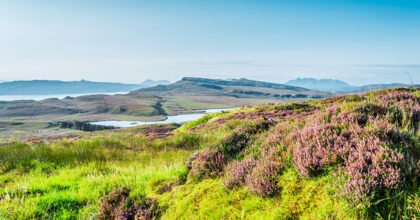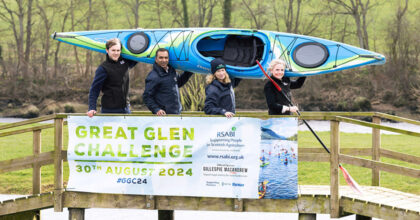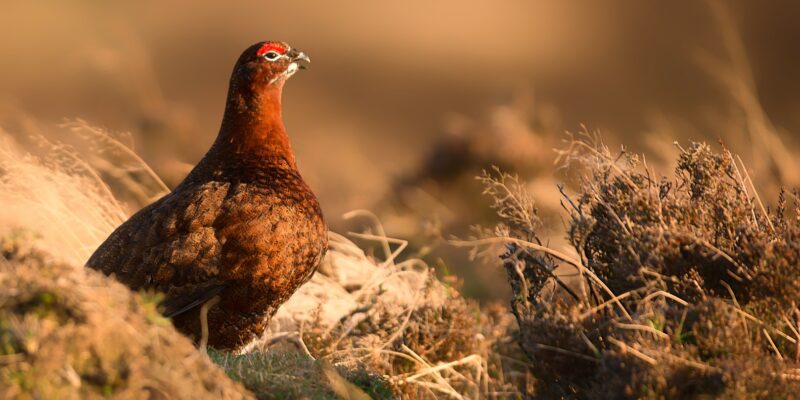On Wednesday 22 March 2023, the Scottish Government introduced the much-anticipated Wildlife Management and Muirburn (Scotland) Bill to the Scottish Parliament. The restrictions contained in the bill are wide ranging and, if passed, will have a significant effect on rural Scotland.
The headline provisions of the bill include the introduction of:
- a licensing scheme for the killing or taking of certain birds (initially red grouse only);
- a year-round licensing scheme for muirburn;
- a ban on the use of glue traps;
- a licensing scheme for the use of certain wildlife traps; and
- enabling powers that certain persons may be appointed to exercise in relation to wildlife crime investigations.
The key features of the flagship licensing schemes for grouse shooting and muirburn are outlined below.
Licences for the killing and taking of certain birds
The bill inserts a new part 1B to schedule 2 to the Wildlife and Countryside Act 1981 (“the 1981 Act”) and provides that species included in part 1B can only legally be killed or taken on land where there is an unsuspended “section 16AA licence” (referred to in the policy memorandum as a “grouse moor management licence”).
Part 1B currently only includes red grouse. However, the bill empowers the Scottish ministers to add further birds to the section 16AA licensing regime if they think it appropriate to do so via secondary legislation. The consultation preceding the bill did not signal an intention to regulate other species so it is likely come that this broad enabling power will come as a surprise to rural stakeholders without grouse interests, who will see this as a change that could have significant downstream consequences for the sector more broadly.
The bill’s policy memorandum says the purpose of the scheme is to “address the ongoing issue of wildlife crime, and in particular the persecution of raptors, on managed grouse moors. It will do this by enabling a licence to be modified, suspended or revoked, where there is robust evidence of raptor persecution, or another relevant wildlife crime related to grouse moor management”.
The key features of the scheme are as follows:
- The licence holder will be the person who holds the right to shoot certain birds (the landowner or sporting tenant where rights have been assigned).
- The licensing authority is likely to be NatureScot.
- The nature and extent of the information an applicant must submit when applying for a licence is not prescribed in the bill. That is a matter to be determined by NatureScot, who will issue detailed guidance outlining the evidence it requires.
- Licences may only be granted if NatureScot is satisfied that it is “appropriate” to do so. The bill does not define or provide any guidance on what “appropriate” means other than obliging NatureScot to have regard in particular to the applicant’s compliance with a code of practice (more on that below) in determining whether it is appropriate to grant a licence.
- NatureScot are obliged to specify any conditions it considers appropriate to attach to the licence, which must include an obligation to “have regard to” the code of practice. Beyond that the policy memorandum provides no direction as to the nature of licence conditions to be imposed, however they will be need to reasonable and in keeping with the purpose of the licensing scheme.
- Licences may only be granted or renewed for a maximum period of one year. This is likely to be a key issue in debates about the workability of the scheme.
- Licences can be modified by NatureScot at any time. There is no requirement for NatureScot to provide advance notice of modifications before they take effect.
- The penalties under the scheme are licence suspension or revocation, which have the effect of removing the landowners right to shoot or permit others to shoot red grouse on their land for the period the penalty applies. NatureScot will provide notice of suspension or revocation, but do not require to give the licence holder an opportunity to be heard in advance. No upper time limits for suspension or revocation are prescribed in the bill but it seems logical that if licences are valid for a maximum period one year, the maximum period of licence suspension or revocation is one year. After that point, the key question is likely to be whether NatureScot consider it “appropriate” to grant or renew the licence.
- Licence suspension or revocation may be imposed by NatureScot if:
(a) there is a failure to comply with licence conditions;
(b) a licence holder ceases to be in a position to ensure compliance with the code of practice; or
(c) it is satisfied that the licence holder or “a person involved in managing the land” has committed a relevant offence, or caused or permitted another person to do so. Questions will likely be asked about what level of personnel may be said to be involved in land management, and whether the actions of a person who has no involvement in the management of the land for grouse could result in the grouse shoot licence being suspended or removed (for example, a farmer or agricultural tenant who operates on the same land). - In addition, NatureScot may suspend (but not revoke) a licence if they are not satisfied that a relevant offence has been committed by the licence holder or a person managing the land in cases where there exists an official investigation or proceedings in relation to a suspected relevant offence on the land, and the suspect is the licence holder or other person managing the land. It appears possible that an official investigation could be initiated by the recording of a complaint or report, meaning there is no need for proof of crime to the civil or criminal standard before a licence can be suspended. There appears to be no obligation on NatureScot to share any information with the licence holder in advance of suspension or to notify the licence holder that it is considering such suspension.
- The definition of “relevant offences” comprises of a wide range wildlife offences under Part 1 of the 1981 Act, The Protection of Badgers Act 1992, Part 3 of the Conservation (Natural Habitats etc.) Regulations 1994 (SI 1994 No. 2716), Section 1 of the Wild Mammals (Protection) Act 1996 and The Hunting with Dogs (Scotland) Act 2023. This list can be amended by Scottish Ministers through regulations.
- The code of practice will be developed by NatureScot (likely after the bill passes) and it seems clear that it will play a large role in the licensing scheme. It will make reference to (i) how land should be managed to reduce disturbance and harm to wild animals, birds and plants; (ii) how the taking or killing of wild birds should be carried out; and (iii) how predators should be controlled and is to be consulted upon and reviewed every five years.
- NatureScot’s licensing decisions can be appealed in the sheriff court by way of review on the merits. This right will undoubtedly be welcomed by parties affected by the scheme in principle but given licences will be valid for a maximum period of one year and appeals to the sheriff (and potentially beyond) could take up to a year or even longer, questions will likely be asked about the utility of it in practice.
- Licensing fees are likely to be charged to the applicant. This is notable because although NatureScot do not currently operate licences on a cost recoverable basis, the Scottish Government/Scottish Green Party Shared Policy Programme contains the commitment to review the wider species licensing system and assess the potential to apply the principle of full cost recovery to species licensing.
The bill also introduces two new offences related to section 16AA licences:
- The offence of killing or taking a part 1B bird without a s 16AA licence being in place. Such an offence could result in (i) on summary conviction, imprisonment for up to 12 months or a fine up to £40,000; or (ii) on conviction of indictment, imprisonment for up to five years, an unlimited fine, or both. It would be a defence if a person who killed or took a part 1B bird reasonably believed a s 16AA licence was in place.
- Making a false statement in obtaining a s 16AA licence. Such an offence could result in, on summary conviction: (i) imprisonment for up to six months; (ii) a fine of up to £5,000; or (iii) both.
Muirburn
The bill repeals the muirburn provisions in the Hill Farming Act 1946 and replaces them with provisions to require a licence all year round to undertake muirburn on any land in Scotland in all land management contexts (including crofting, farming and management of land for grouse) with different licence conditions applying depending on whether this is carried out during the muirburn season, outwith the muirburn season or on peatland.
The policy memorandum says the purpose of the licensing scheme is to “ensure that muirburn is being undertaken in an environmentally sustainable manner, with due consideration of all the possible consequences”. It goes on to state that there is currently no scientific consensus on the effects of muirburn, therefore the bill contains powers to modify the regulations of muirburn in the future, as further scientific evidence is developed.
The key features of the licensing scheme are as follows:
- The landholding on which it is intended that muirburn be carried out is being licensed. This means that any landowner or occupier wishing to make muirburn will require a licence to do so.
- The licensing authority is likely to be NatureScot.
- There are two types of licence applications: (a) licences related to “peatland” (defined as land with peat deeper than 40cm); and (b) licences related to non-peatland (which apply to land where the peat is shallower than 40cm). There are different licensable purposes for non-peatland and peatland licences which can be amended by regulation.
- Every muirburn licence is conditional on the person (i) to whom the licence is issued having regard to the muirburn code; and (ii) the person intending to make muirbuirn on the land having regard to the muirburn code and complying with the requirements to give notice before making muirburn set out in section 15 of part 2 of the bill. Additional conditions may be introduced in future, which may relate in particular to the provisions of the muirburn code (i.e. regulating how muirburn is to be conducted), the persons or types of person who can legally conduct muirburn (there is currently no restriction to that effect), reporting requirements and additional requirements in relation to giving notice period to making muirburn.
- To obtain a licence, applicants will have to specify (a) who the licence holder will be; (b) the land to which the application relates through provision of a map; (c) whether the land is peatland or non-peatland; (d) the licensable purpose for making muirburn; and (e) the period for which the licence is to have effect. Licences cannot be granted if a licensable purpose is not met. In practice, this places an obligation on the applicant to determine whether the land is peatland or non-peatland, in accordance with guidance to be developed by NatureScot. A recent review into the evidence on muirburn commissioned by NatureScot concluded that the use of manual peat probes is probably the most practical method for measuring peat depth but indicated that this is not practical over large areas of land. It will be interesting to see how this is developed in due course.
- For non-peatland licences, the licensable purposes are (a) managing habitats of moorland game or wildlife; (b) improving the grazing potential of moorland for livestock; (c) conserving, restoring, enhancing or managing the natural environment; (d) preventing, or reducing the risk of, wildfires causing harm to people and damage to property; and (e) research.
- For peatland licences, the licensable purposes are (a) restoring the natural environment; (b) preventing, or reducing the risk of, wildfires causing damage to habitats; (c) preventing, or reducing the risk of, wildfires causing harm to people and damage to property; and (d) research.
- NatureScot must be satisfied that the licence is necessary to achieve the licensable purpose specified in the application. For peatland licences, it must also be satisfied that no other method of vegetation control is available to meet that purpose, effectively making muirburn the vegetation management tool of last resort.
- Licences will be valid for such period as prescribed by NatureScot. The policy memorandum suggests a period of 12 months.
- Licences may be suspended or revoked if NatureScot is satisfied that a “relevant person” has committed an offence under part 2 of the bill (offences related to muirburn). “Relevant person” means a person to whom the licence was issued, or any other person managing the land to which the licence relates. There is no maximum period of suspension or revocation prescribed in the bill.
- As with section 16AA licences, licences may be suspended (but not revoked) if NatureScot is not satisfied that such an offence has been committed in cases where there exists an official investigation or proceedings in relation to such an offence, and the suspect is a relevant person.
- Written notice of modification, suspension or revocation will be provided by NatureScot prior to the measure taking effect and will set out the reasons for intervention. There is no right to appeal against decisions of NatureScot to the Sheriff Court.
- Licensing fees are likely to be charged to the applicant.
- NatureScot will develop a new muirburn code in relation to how to make muirburn safely and appropriately. The code will be reviewed within five years of muirburn licensing being in force, and then every five years thereafter, with revisions made on the back of each review (if required). The code will likely make reference to (a) how the thickness of a layer of peat is to be determined (as noted above); (b) the times of day muirburn can be made; and (c) safety requirements when making muirburn.
The bill also introduces two new offences related to muirburn licences which could result in, on summary conviction (i) imprisonment for up to six months; (ii) a fine of up to £5,000; or (iii) both. They are:
- To knowingly or recklessly make any statement which is false in any material particular for the purpose of obtaining a muirburn licence. This creates a significant liability for landowners and occupiers tasked with determining the depth of peat when applying for a licence.
- To make muirburn without a licence being in place, or to cause or permit someone to make muirburn without a licence being in place, unless there is a reasonable excuse for doing so. It would not be an offence to make muirburn on peatland if the muirburn licence specifies that the land is not peatland, meaning people employed or contracted to make muirburn on behalf of the applicant do not have criminal liability for the wrongdoing of the applicant.
Next steps
The bill is currently at stage 1 and is being considered by the Rural Affairs & Islands Committee. The call for evidence from interested parties closed earlier this month and attracted over 5,000 responses. Key stakeholders have raised several questions of detail that will need to be addressed and it will be interesting to see to what extent the bill will be amended to reflect competing concerns.
The Scottish Government acknowledges that the proposed restrictions interfere with rights that are protected by the European Convention on Human Rights, the most relevant of which is likely to be Article 1 of the First Protocol, which includes related procedural rights. It follows that it needs to demonstrate, in respect of any set of restrictions it seeks to introduce, that these would pursue a legitimate aim, would be effective in achieving that aim, and in any case are proportionate in all the circumstances. Any legislation which falls short of that standard may be vulnerable to legal challenge either by the UK Government or those affected by the legislation.
If you would like any support with understanding how the Bill might affect you or your business, please get in touch.






